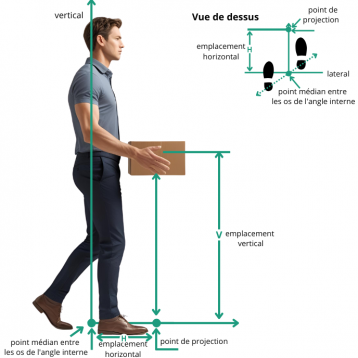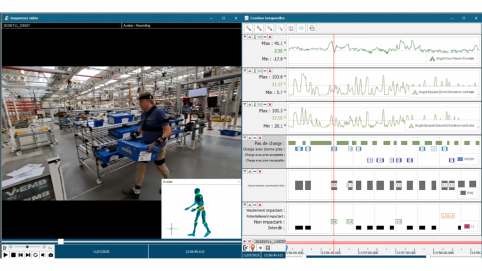Evaluating Risks of musculoskeletal disorders with the NIOSH Equation: A Reliable Method Available in CAPTIV Score
Musculoskeletal disorders (MSDs) are among the most common occupational health risks, especially in tasks involving manual lifting. To anticipate and reduce these risks, the equation developed by the National Institute for Occupational Safety and Health (NIOSH) has become a key reference. Good news: this method is now integrated into CAPTIV Score, the ergonomic analysis solution developed by TEA Tech Ergo Appliquées.
📏 What is the NIOSH Equation?
The NIOSH equation helps determine the Recommended Weight Limit (RWL) for a lifting task in order to minimize injury risk. It considers several biomechanical parameters related to the lifting gesture and the work environment.

🧮 NIOSH Equation
RWL = LC × HM × VM × DM × AM × FM × CM
Where:
- RWL (Recommended Weight Limit): Maximum recommended load
- LC (Load Constant) = 23 kg (baseline value)
- HM (Horizontal Multiplier): Horizontal distance between hands and the body
- VM (Vertical Multiplier): Vertical position of the hands at the start of the lift
- DM (Distance Multiplier): Vertical travel distance of the load
- AM (Asymmetry Multiplier): Degree of trunk rotation
- FM (Frequency Multiplier): Lifting frequency
- CM (Coupling Multiplier): Quality of the hand-to-object coupling
Then, the Lifting Index (LI) is calculated:
LI = Actual Load (kg) / RWL (kg)
👉 The Lifting Index (LI) indicates the ratio between the actual lifted weight and the recommended limit. The higher the LI, the greater the risk. An LI over 1 signals an increased risk of MSDs.
🔍 Analysis Method
The integration of the NIOSH equation into CAPTIV Score enables a complete, structured, and objective analysis of manual material handling through motion capture sensors. The method follows a clear and effective logic:
- Placement of motion sensors on the worker (torso, arms, legs)
- Measurement over a representative period with video synchronization
- Identification of lifting phases directly within CAPTIV
- Automatic calculation of key indicators:
- RWL (Recommended Weight Limit)
- LI (Lifting Index)
This approach provides a reliable, traceable, and prevention-oriented ergonomic evaluation, making it easier to take action to improve workstations and reduce MSD risks.

✅ Application Conditions
The NIOSH equation applies only to lifting tasks that meet the following conditions:
- Two-handed lifting
- Performed while standing
- Lifting of stable loads
- In a standard environment (e.g., normal temperature, non-slippery surface)
⚙️ Key Evaluation Factors
The NIOSH method incorporates the following factors:
- Base weight (Load Constant): 23 kg
- Initial vertical position (VM)
- Vertical travel distance (DM)
- Horizontal distance (HM) from body to object
- Asymmetry (AM): Trunk rotation
- Lifting frequency (FM)
- Coupling (CM): Quality of grip (good, fair, poor)
🛠️ Practical Use Cases
Here are a few real-world scenarios where the NIOSH equation proves effective:
- Manual handling in industry (logistics, warehouses)
- Lifting of boxes in retail
- Stocking heavy products on shelves
- Repetitive lifting on construction sites
- Loading/unloading trucks with ergonomic improvement suggestions
🧾 Summary
The integration of the NIOSH equation into CAPTIV Score by TEA Tech Ergo Appliquées provides a rigorous and automated method to assess MSD risks related to lifting tasks. It’s a valuable step forward in protecting workers’ health and optimizing workplace ergonomics.
📍 Learn More
- Visit the contact page: clone.teaergo.com/contact
- 📧 Email: contact@teaergo.com
- 📞 Phone: +33 (0)3 83 44 08 09
